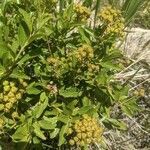Shrubs, deciduous, 0.6–1 m. Stems erect to ascending, not rooting at nodes; branchlets green, brown, or reddish, not thorn-tipped, round in cross section, flexible, ± appressed-puberulent or villosulous, glabrescent. Leaves: petiole 2–6(–10) mm; blade not aromatic, flat, usually elliptic to lanceolate, sometimes ovate or oblanceolate, (20–)25–70 × 10–30 mm, herbaceous, not resinous, base cuneate to rounded, margins serrate to serrulate, teeth (37–)45–71, apex acute to obtuse, abaxial surface pale green, glabrous or puberulent, especially on veins, adaxial surface dark green, dull, villosulous or glabrate; 3-veined from base. Inflorescences terminal, umbel-like, globose to hemispheric, 4–8 cm. Flowers: sepals, petals, and nectary white. Capsules 3–5 mm wide, lobed; valves smooth, usually not crested, sometimes weakly crested near apex.
More
Bushy shrub to 1 m; lvs typically oblong to elliptic, varying to lance-oblong or oblanceolate-oblong, 2–6 × 1–2 cm, obtuse or subacute, the lateral nerves never naked and often arising unevenly 1–3 mm above the base of the lf; panicles several to many, terminating the leafy branches of the season, on peduncles rarely to 5 cm, hemispheric to short-ovoid, the component umbels closely set; fr 4–5 mm. Sandy or rocky soil, prairies, and plains; a few stations in Vt., N.Y., and Que.; Mich. to Minn. and e. Mont., s. to nw. Ind., Ark., and Tex. May, June. (C. ovatus; C. pubescens)
An evergreen shrub or small tree. It grows 0.9-3 m high and spreads 90 cm wide. It loses its leaves during the year. The flowers are small and white. The fruit are dry seed capsules. They turn red in summer.
Can be grown by cuttings or seedlings. Seeds needs soaking.

